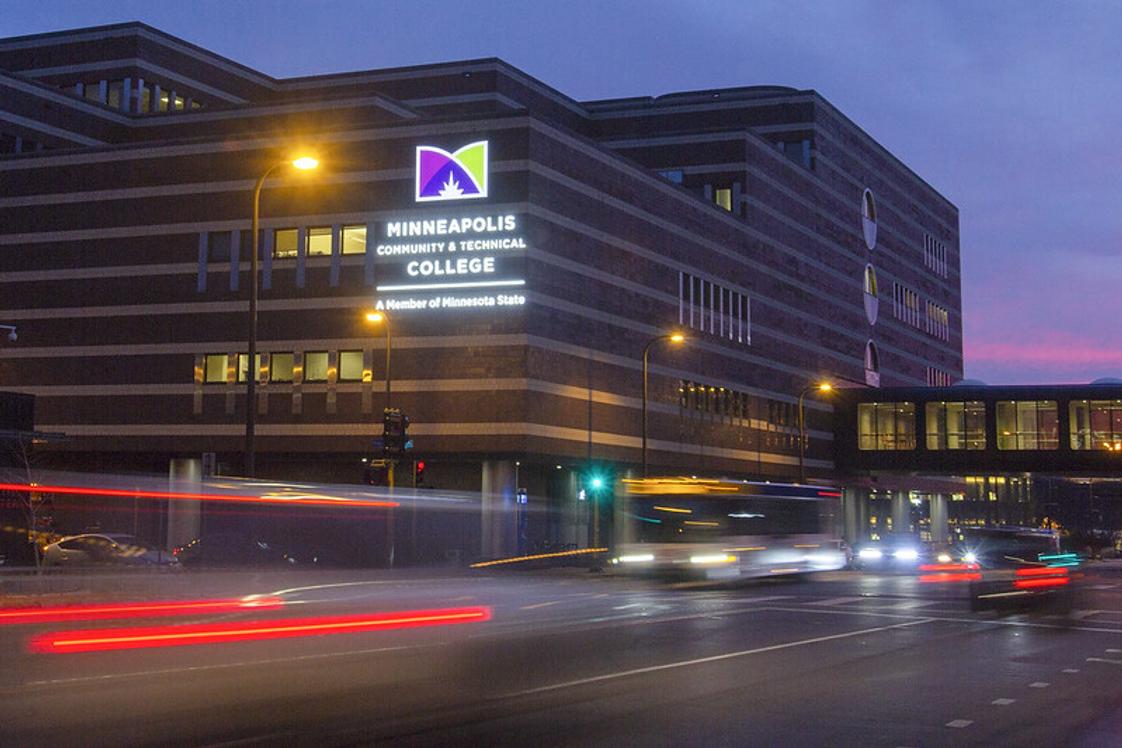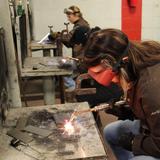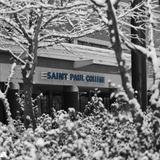- Minneapolis College is a public community college in Minneapolis, Minnesota. It has one of the most diverse student populations in the state and enrolls nearly 11,100 credit students annually. Minneapolis College is part of Minnesota State, which offers two-year associate degrees, certificates, and diplomas.
School Highlights
Minneapolis Community and Technical College serves 9,199 students (24% of students are full-time).
The college's student-teacher ratio of 24:1 is higher than the state community college average of 22:1.
Minority enrollment is 67% of the student body (majority Black), which is more than the state average of 42%.
Quick Facts (2025-26)
- Enrollment: 9,199 students
- In-state tuition: $5,350
- Out-state tuition: $5,350
- Student-teacher ratio: 24:1
- Minority enrollment: 67%
- Source: Integrated Postsecondary Education Data System (IPEDS)
Top Rankings
Minneapolis Community and Technical College ranks among the top 20% of public schools in Minnesota for:
Category
Attribute
Affordability
Diversity
Community Size
School Overview
The teacher population of 391 teachers has stayed relatively flat over five years.
Minneapolis Community and Technical College
(MN) Community College Avg.
Carnegie Classification
Associate's Colleges: Mixed Transfer/Career & Technical-Mixed Traditional/Nontraditional
Associate's Colleges: Mixed Transfer/Career & Technical-Mixed Traditional/Nontraditional
Institution Level
At least 2 but less than 4 years
At least 2 but less than 4 years
Institution Control
Public
Public
Total Faculty
391 staff
171 staff
School Calendar
Student Body
The student population of Minneapolis Community and Technical College has grown by 31% over five years.
The student-teacher ratio of 24:1 has increased from 16:1 over five years.
The Minneapolis Community and Technical College diversity score of 0.75 is more than the state average of 0.63. The school's diversity has stayed relatively flat over five years.
Total Enrollment
9,199 students
2,858 students
Student-Teacher Ratio
24:1
22:1
# Full-Time Students
2,218 students
1,050 students
# Part-Time Students
6,981 students
1,808 students
# Enrollment Undergraduate
919 students
420 students
# Full-Time Undergraduate Students
2,218 students
915 students
# Full-Time Graduate Students
n/a
38 students
# Part-Time Undergraduate Students
6,981 students
1,771 students
# Part-Time Graduate Students
n/a
12 students
Total Dormitory Capacity
n/a
116 students
% American Indian/Alaskan
1%
1%
% Asian
5%
6%
% Hispanic
13%
8%
% Black
34%
15%
% White
33%
58%
% Hawaiian
n/a
1%
% Two or more races
6%
4%
% Non Resident races
2%
1%
% Unknown races
5%
6%
Diversity Score
0.75
0.63
College Completion Rate (Students who graduate in less than 4 years)
14%
34%
College Completion Rate (Students who graduate in 4 years or more than 4 years)
n/a
57%
Average Graduate Earnings (10 Years)
$36,900
$36,900
Tuition and Acceptance Rate
The public in-state tuition of $5,350 is less than the state average of $5,489. The in-state tuition has declined by 5% over four years.
The public out-state tuition of $5,350 is less than the state average of $6,145. The out-state tuition has declined by 5% over four years.
In-State Tuition Fees
$5,350
$5,489
Out-State Tuition Fees
$5,350
$6,145
Tuition Notes
$500,000 in scholarships awarded every year
% Students Receiving Some Financial Aid
77%
89%
Median Debt for Graduates
$18,890
$12,264
Median Debt for Dropouts
$9,500
$6,750
Acceptance Rate
n/a
94%
SAT Reading
n/a
625
SAT Math
n/a
600
SAT Writing
n/a
565
ACT Composite
n/a
24
ACT English
n/a
24
ACT Math
n/a
23
ACT Writing
n/a
8
Extracurriculars
Total ExtracurricularsTotal Extra-curric.
25 extracurriculars
ExtracurricularsExtra-curric.
Club or Organization:
Arts and Music Programs:
3 Legged Frog- Environmental ClubAddiction Counseling Club
American Sign Language ClubAnime Club
Basketball ClubBike Collective
Christian Student AssociationCity College News- Studnet Newspaper
Cyber DefenseFlag Football Club
Math ClubPhi Theta Kappa Honor Society
PRIDE ClubRaíces Unidas
SkillsUSASoccer Club
Student Nurses AssociationStudent Senate
Students Against Hunger & HomelessnessUnited Nations of Indian Tribes for Education
Urban Farm CollectiveVoyageur Outward Bound - Outdoor Adventures Program
Arts and Music Programs:
ChoirJazz Ensemble
Theater
Source: 2024 (or latest year available) Integrated Postsecondary Education Data System (IPEDS)
School Notes
- School Mascot: Wild Boars
Frequently Asked Questions
How much does Minneapolis Community and Technical College cost?
Minneapolis Community and Technical College's tuition is approximately $5,350 for In-State students and $5,350 for Out-State students.
What is Minneapolis Community and Technical College's ranking?
Minneapolis Community and Technical College ranks among the top 20% of community college in Minnesota for: Least expensive tuition, Diversity in US community colleges and Largest student body.
In what neighborhood is Minneapolis Community and Technical College located?
Minneapolis Community and Technical College is located in the Central Minneapolis neighborhood of Minneapolis, MN. There are 1 other community '.college.' located in Central Minneapolis.
Recent Articles

The Rise of Technical and Vocational Training in 2025
Explore the 2025 surge in technical and vocational training—enrollment, policy, costs, and why this path is gaining ground for students and parents.

Stackable Credentials: How Community Colleges Advance Careers
Discover how community colleges use stackable credentials to build career pathways, boost earnings, and enable lifelong learning in 2025.

High-Paying Jobs You Can Get with a Community College Degree
Discover top high-paying careers you can launch in 2025 with a community college (associate) degree and high-growth credentials in tech, healthcare and trades.















